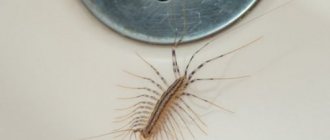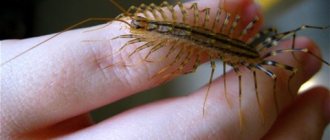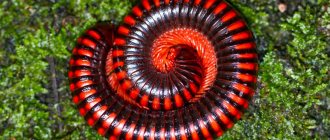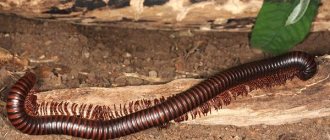| Chinese red centipede | |
| Scientific classification | |
| Kingdom: | Animalia |
| Type: | Arthropods |
| Class: | Chilopoda |
| Order: | Scolopendromorpha |
| Family: | Scolopendrides |
| Genus: | Scolopendra |
| Variety: | S. subspinipes |
| Subspecies: | SS. mutilans |
| Trinomial name | |
| Scolopendra subspinipes mutilans L. Koch, 1878 | |
The Chinese red centipede
, also known as
the Chinese red head
, (
Scolopendra subspinipes mutilans
) is a centipede native to East Asia and Australasia. [1] It averages 20 cm (8 in) in length and lives in moist environments.
Play media
Chinese red centipede
In ancient Chinese traditions, this centipede is used for its medicinal properties. Applying Red Chinese Head to a rash or other skin condition is said to speed up the healing process. Roasted dry centipede is ground into powder and used in Korea to treat back pain, boils and sores.[2]
Scolopendra subspinipes mutilans
is known for not being aggressive towards other centipedes, which is very rare among giant centipedes and allows it to be kept together.
Females are hatchery mothers and guard the eggs by wrapping their bodies around the clutch until it hatches.
Chinese bamboo torture
A notorious method of terrible Chinese execution throughout the world. Perhaps a legend, because to this day not a single documentary evidence has survived that this torture was actually used.
Bamboo is one of the fastest growing plants on Earth. Some of its Chinese varieties can grow a full meter in a day. Some historians believe that the deadly bamboo torture was used not only by the ancient Chinese, but also by the Japanese military during World War II.
Bamboo grove. (pinterest.com)
How it works?
1) Sprouts of living bamboo are sharpened with a knife to form sharp “spears”; 2) The victim is suspended horizontally, with his back or stomach, over a bed of young pointed bamboo; 3) The bamboo quickly grows high, pierces the skin of the martyr and grows through his abdominal cavity, the person dies for a very long time and painfully.
Like torture with bamboo, the “iron maiden” is considered by many researchers to be a terrible legend. Perhaps these metal sarcophagi with sharp spikes inside only frightened the people under investigation, after which they confessed to anything.
Who was tortured?
This type of punishment was subjected to all people disliked by the higher ranks. Such manipulations and murders were commonplace. Like most countries of that period of time, the Celestial Empire invented its own methods of executions. Their prevalence was explained by the fact that monetary compensation or placement in prison to serve a sentence were considered unworthy punishments. Anyone who broke the law was subjected to torture. At that time they were:
- the thieves;
- spies;
- people who did not believe in God;
- women who gave birth to children without a husband;
- representatives of non-traditional orientation;
- those who cheated on their husband or wife;
- people disliked by the government.
"Iron Maiden"
The “Iron Maiden” was invented at the end of the 18th century, i.e. already at the end of the Catholic Inquisition.
"Iron Maiden". (pinterest.com)
How it works?
1) The victim is stuffed into the sarcophagus and the door is closed; 2) The spikes driven into the inner walls of the “iron maiden” are quite short and do not pierce the victim, but only cause pain. The investigator, as a rule, receives a confession in a matter of minutes, which the arrested person only has to sign; 3) If the prisoner shows fortitude and continues to remain silent, long nails, knives and rapiers are pushed through special holes in the sarcophagus. The pain becomes simply unbearable; 4) The victim never admits to what she had done, so she was locked in a sarcophagus for a long time, where she died from loss of blood; 5) Some Iron Maiden models had spikes at eye level to poke them out.
The name of this torture comes from the Greek “scaphium”, which means “trough”. Scaphism was popular in ancient Persia. During the torture, the victim, most often a prisoner of war, was devoured alive by various insects and their larvae who were partial to human flesh and blood.
Skafism. (pinterest.com)
How it works?
1) The prisoner is placed in a shallow trough and wrapped in chains. 2) He is force-fed large quantities of milk and honey, which causes the victim to have profuse diarrhea, which attracts insects. 3) The prisoner, having shit himself and smeared with honey, is allowed to float in a trough in a swamp, where there are many hungry creatures. 4) The insects immediately begin their meal, with the living flesh of the martyr as the main course.
The dangers of centipedes
The pintail is an insect that does not cause harm to humans, except for the discomfort that arises when meeting it. Despite its scary appearance, the centipede cannot cause physical harm. Having met in a house, many people ask the question: “Is a centipede an insect or not?” It belongs to a separate class of arthropods. An insect with many legs in an apartment will sit in a dark corner, and in the dark it will come out in order to saturate the body with small goosebumps or waste. It is also safe for pets. An arthropod will not be able to snack on dense skin.
Important! The centipede is not a carrier of diseases and does not damage the furniture in the house. She tries to stay as far away from her owners as possible without being seen.
If contact occurs, the centipede will run away rather than fight. She can bite only in case of self-defense, which is completely safe for human health. The only thing that can happen is an allergic reaction to its venom, which will soon pass after the bite. Still, people are not used to sharing space with unpleasant insects; they try to get rid of them as soon as possible
She tries to stay as far away from her owners as possible without being seen. If contact occurs, the centipede will run away rather than fight. She can bite only in case of self-defense, which is completely safe for human health. The only thing that can happen is an allergic reaction to its venom, which will soon pass after the bite. Still, people are not used to sharing space with unpleasant insects; they try to get rid of them at the first opportunity.
Pear of suffering
This cruel tool was used to punish abortionists, liars and homosexuals. The device was inserted into the vagina for women or the anus for men. When the executioner turned the screw, the “petals” opened, tearing the flesh and bringing unbearable torture to the victims. Many then died from blood poisoning.
A pear of suffering. (pinterest.com)
How it works?
1) A tool consisting of pointed pear-shaped leaf-shaped segments is inserted into the client’s desired body hole; 2) The executioner little by little turns the screw on the top of the pear, while the “leaves” segments bloom inside the martyr, causing hellish pain; 3) After the pear is completely opened, the offender receives internal injuries incompatible with life and dies in terrible agony, if he has not already fallen into unconsciousness.
copper bull
The design of this death unit was developed by the ancient Greeks, or, to be more precise, by the coppersmith Perillus, who sold his terrible bull to the Sicilian tyrant Phalaris, who simply loved to torture and kill people in unusual ways.
A living person was pushed inside the copper statue through a special door. And then Phalaris first tested the unit on its creator - the greedy Perilla. Subsequently, Phalaris himself was roasted in a bull.
Copper bull. (pinterest.com)
How it works?
1) The victim is closed in a hollow copper statue of a bull; 2) A fire is lit under the bull’s belly; 3) The victim is roasted alive; 4) The structure of the bull is such that the cries of the martyr come from the mouth of the statue, like a bull’s roar; 5) Jewelry and amulets were made from the bones of the executed, which were sold at bazaars and were in great demand.
Torture by rats was very popular in ancient China. However, we will look at the rat punishment technique developed by the 16th century Dutch Revolution leader Diedrich Sonoy.
Torture by rats. (pinterest.com)
How it works?
1) The stripped naked martyr is placed on a table and tied; 2) Large, heavy cages with hungry rats are placed on the prisoner’s stomach and chest. The bottom of the cells is opened using a special valve; 3) Hot coals are placed on top of the cages to stir up the rats; 4) Trying to escape the heat of hot coals, rats gnaw their way through the flesh of the victim.
Interesting facts about scolopendra
We offer some interesting and unusual facts about scolopendra:
- crushing a centipede is not easy - it presses its flat body into the ground, as if going deeper;
- there is a species with a blue body color - rhizida, found in southern Africa;
- African peoples and residents of Thailand eat them;
- the ancient Greeks called all centipedes centipedes;
- they are not sensitive to fumigators used against various insects;
- preparations based on scolopendra act as antispasmodics, treat skin diseases, rheumatism, and help remove kidney stones.
Cradle of Judas
The Judas Cradle was one of the most torturous torture machines in the arsenal of the Suprema - the Spanish Inquisition. Victims usually died from infection, due to the fact that the pointed seat of the torture machine was never disinfected. The Cradle of Judas, as an instrument of torture, was considered “loyal” because it did not break bones or tear ligaments.
Cradle of Judas. (pinterest.com)
How it works?
1) The victim, whose hands and feet are tied, is seated on the top of a pointed pyramid; 2) The top of the pyramid is thrust into the anus or vagina; 3) Using ropes, the victim is gradually lowered lower and lower; 4) The torture continues for several hours or even days until the victim dies from powerlessness and pain, or from blood loss due to rupture of soft tissues.
Rack
Probably the most famous and unrivaled death machine of its kind called the “rack”. It was first tested around 300 AD. e. on the Christian martyr Vincent of Zaragoza.
Anyone who survived the rack could no longer use their muscles and became a helpless vegetable.
Rack. (pinterest.com)
How it works?
1. This instrument of torture is a special bed with rollers at both ends, around which ropes are wound to hold the victim’s wrists and ankles. As the rollers rotated, the ropes pulled in opposite directions, stretching the body; 2. Ligaments in the victim’s arms and legs are stretched and torn, bones pop out of their joints. 3. Another version of the rack was also used, called strappado: it consisted of 2 pillars dug into the ground and connected by a crossbar. The interrogated person's hands were tied behind his back and lifted by a rope tied to his hands. Sometimes a log or other weights were attached to his bound legs. At the same time, the arms of the person raised on the rack were turned back and often came out of their joints, so that the convict had to hang on his outstretched arms. They were on the rack from several minutes to an hour or more. This type of rack was used most often in Western Europe 4. In Russia, a suspect raised on a rack was beaten on the back with a whip and “put to the fire,” that is, burning brooms were passed over the body. 5. In some cases, the executioner broke the ribs of a man hanging on a rack with red-hot pincers.
Reproduction of the common flycatcher
When insects begin the breeding season, usually in spring and summer, the female begins to secrete special pheromones so that the male pays attention to her. When the acquaintance occurs, the male lays a small cell with sperm, which picks up a female individual with his reproductive tract
She then digs a hole in the damp soil and places 70 to 120 fertilized eggs in it and sprinkles them lightly with soil to camouflage them.
Small centipedes are born with four pairs of legs, then their number increases after each molt. After 5–6 molts, the flycatcher grows and the number of legs is 15 pairs. The lifespan of a house centipede is about 3–7 years.
Shiri (camel cap)
A monstrous fate awaited those whom the Ruanzhuans (a union of nomadic Turkic-speaking peoples) took into slavery. They destroyed the slave's memory with a terrible torture - putting a shiri on the victim's head. Usually this fate befell young men captured in battle.
Shiri. (pinterest.com)
How it works?
1. First, the slaves' heads were shaved bald, and every hair was carefully scraped out at the root. 2. The executors slaughtered the camel and skinned its carcass, first of all, separating its heaviest, dense nuchal part. 3. Having divided it into pieces, it was immediately pulled in pairs over the shaved heads of the prisoners. These pieces stuck to the heads of the slaves like a plaster. This meant putting on the shiri. 4. After putting on the shiri, the neck of the doomed person was chained in a special wooden block so that the subject could not touch his head to the ground. In this form, they were taken away from crowded places so that no one would hear their heartbreaking screams, and they were thrown there in an open field, with their hands and feet tied, in the sun, without water and without food. 5. The torture lasted 5 days. 6. Only a few remained alive, and the rest died not from hunger or even from thirst, but from unbearable, inhuman torment caused by drying, shrinking rawhide camel skin on the head. Inexorably shrinking under the rays of the scorching sun, the width squeezed and squeezed the slave's shaved head like an iron hoop. Already on the second day, the shaved hair of the martyrs began to sprout. Coarse and straight Asian hair sometimes grew into the rawhide; in most cases, finding no way out, the hair curled and went back into the scalp, causing even greater suffering. Within a day the man lost his mind. Only on the fifth day did the Ruanzhuans come to check whether any of the prisoners had survived. If at least one of the tortured people was found alive, it was considered that the goal had been achieved. 7. Anyone who underwent such a procedure either died, unable to withstand the torture, or lost his memory for life, turned into a mankurt - a slave who does not remember his past. 8. The skin of one camel was enough for five or six widths.
Habits, instincts and life of the flycatcher: the most interesting
You should know that the centipede (the photo will not allow you to make a mistake) is an insect that is equally active at any time of the day. Every hour, every minute she looks for prey. As soon as the victim is identified, the flycatcher injects a portion of a toxic substance into it to neutralize it and only after that it eats it without haste. The insect is very fast, capable of covering up to 40 centimeters in one second.
On average, a female flyeater lays up to 6 dozen eggs at a time. All of them are protected with a sticky substance and placed in a hole or deep crack carefully dug by mom. The insect carefully wraps its body around the clutch of eggs and tries to close it from the outside world with its paws. In this way, the scolopendra “nurses” the eggs for many weeks, without leaving the nest even a centimeter, and does not eat or drink anything.
The common centipede is an insect with a mission. Being a representative of the most ancient inhabitants of the planet, it deserves special attention. At first glance, scary and unpleasant insects actually provide invaluable assistance to humans by eating a lot of pests, for example:
- cockroaches;
- fleas;
- ants;
- bedbugs, etc.
There are up to 8,000 species of this insect in the world, but only 3,000 of them have been officially documented, such as the Chinese centipede, which reaches a quarter of a meter in length with a body of 23 sections, or the bright black African centipede with a body up to 28 cm long!
Almost none of the discovered species of centipedes are dangerous to humans. Yes, arthropods can bite, but all that a centipede bite can do is cause allergies, and then only in people who are prone to this kind of reaction with a slight increase in temperature and swelling at the site of the bite.
In the insect world, the centipede is one of the dominant predators with claws on the first segment. She is a carnivore, so she prefers clean meat from small insects. Large species can cope not only with invertebrates, but also with small reptiles, as well as worms, frogs, spiders and even birds.
Spanish water torture
In order to best carry out the procedure of this torture, the accused was placed on one of the types of racks or on a special large table with a rising middle part. After the victim's arms and legs were tied to the edges of the table, the executioner began work in one of several ways. One of these methods involved forcing the victim to swallow a large amount of water using a funnel, then hitting the distended and arched abdomen.
Water torture. (pinterest.com)
Another form involved placing a cloth tube down the victim's throat through which water was slowly poured, causing the victim to swell and suffocate. If this was not enough, the tube was pulled out, causing internal damage, and then inserted again and the process repeated. Sometimes cold water torture was used. In this case, the accused lay naked on a table under a stream of ice water for hours. It is interesting to note that this type of torture was considered light, and the court accepted confessions obtained in this way as voluntary and given by the defendant without the use of torture. Most often, these tortures were used by the Spanish Inquisition in order to extract confessions from heretics and witches.
Actions to take after being bitten
The first step is to remove it from the wound
It is important to understand that when a centipede defends itself, it sprays much more poison than usual. therefore, it is necessary to remove the centipede only with gloves and quite carefully
Next, you need to apply something cold to relieve itching and inflammation.
If a person is allergic, then it is worth taking some kind of anti-allergy drug for prevention.
People prone to allergic reactions should, of course, be wary of various types of bites, since the consequences of a bite may be less joyful.
If after a bite you feel unwell, tired, headaches and dizziness, be sure to call an ambulance, and until it arrives, just lie down and drink more water. Open all windows to bring in fresh air.
Spanish armchair
This instrument of torture was widely used by the executioners of the Spanish Inquisition and was a chair made of iron, on which the prisoner was seated, and his legs were placed in stocks attached to the legs of the chair. When he found himself in such a completely helpless position, a brazier was placed under his feet; with hot coals, so that the legs began to slowly fry, and in order to prolong the suffering of the poor fellow, the legs were poured with oil from time to time.
Spanish armchair. (pinterest.com)
Another version of the Spanish chair was often used, which was a metal throne to which the victim was tied and a fire was lit under the seat, roasting the buttocks. The famous poisoner La Voisin was tortured on such a chair during the famous Poisoning Case in France.
Preventive measures
The appearance of centipedes in an apartment indicates that, in addition to them, harmful insects have appeared in the home, but for some reason the owners of the apartment do not react to this fact
In addition, it is advisable to pay attention to the microclimate in the apartment and get rid of high humidity, especially in the toilet and bathroom, as well as in the kitchen. To prevent creatures that do not belong in your apartment from entering your apartment, it is better to carry out preventive measures in a timely manner that could have a negative effect on insects
For example:
Fight various insects that are part of the flycatcher's diet. She prefers to eat flies, cockroaches and ants. Repair water supply and sewerage systems, eliminating water leaks. If the apartment is damp, then flycatchers will visit the apartment from time to time. Make sure that there are no wet rags left anywhere, especially in the kitchen or bathroom. Dry towels regularly and constantly. If fungus appears in the apartment, it means the apartment is damp. If there is no fungus, then the apartment has a normal microclimate. After bathing in the bathroom, be sure to open windows and doors for ventilation, otherwise condensation may appear. Monitor the condition of the attic and basement, notifying the relevant services, which must promptly respond to comments from residents of multi-story buildings. Check that there are no gaps in the floor, around baseboards, trim, and under window sills
When cracks appear, they must be sealed immediately with sealant. Regularly carry out general cleaning of the apartment, paying special attention to problem areas, as well as promptly remove garbage and get rid of moisture.
This is why you should not squash centipedes in your home!
Watch this video on YouTube
Gridiron (grid for torture by fire)
This type of torture is often mentioned in the lives of saints - real and fictitious, but there is no evidence that the gridiron “survived” until the Middle Ages and had even a small circulation in Europe. It is usually described as an ordinary metal grate, 6 feet long and two and a half feet wide, mounted horizontally on legs to allow a fire to be built underneath.
Sometimes the gridiron was made in the form of a rack in order to be able to resort to combined torture.
Saint Lawrence was martyred on a similar grid.
This torture was used very rarely. Firstly, it was quite easy to kill the person being interrogated, and secondly, there were a lot of simpler, but no less cruel tortures.
Story
During the reign of the Tang Dynasty, important changes took place in the state that affected all areas of life. The drafted legislation did not undergo major changes and lasted until the 20th century. These laws regulated punishments for crimes. Not much is known about torture and executions in China, because surviving sources lack drawings and detailed descriptions of the process.
Some were punished by being beaten with bamboo sticks, forced labor, or expelled. But only people who committed minor crimes were subjected to this. For others, the punishments were more severe. Those sentenced to death were subjected to torture. Death occurred before the intended execution. The cruelty of these actions even today makes one shudder.
Until the beginning of the last century, Chinese law officials had no concept of the presumption of innocence and accusing parties. Confessions obtained during torture served as evidence of an illegal act. These manipulations were subjected not only to suspects, but also to witnesses to the violation. In those days, it was not taken into account that a person could agree to everything in order for his suffering to end. Later they began to use firing squads and did not use the old executions.
Bloody Eagle
One of the most ancient tortures, during which the victim was tied face down and his back was opened, his ribs were broken off at the spine and spread apart like wings. Scandinavian legends claim that during such an execution, the wounds of the victim were sprinkled with salt.
Bloody eagle. (pinterest.com)
Many historians claim that this torture was used by pagans against Christians, others are sure that spouses caught in treason were punished in this way, and still others claim that the bloody eagle is just a terrible legend.
Spanish boot
This is a fastening on the leg with a metal plate, which, with each question and subsequent refusal to answer it, as required, was tightened more and more in order to break the bones of the person’s legs. To enhance the effect, sometimes an inquisitor was involved in the torture, who hit the fastening with a hammer. Often after such torture, all the bones of the victim below the knee were crushed, and the wounded skin looked like a bag for these bones.
Spanish boot. (pinterest.com)
Features of the structure of scolopendra
Although Scolopendra has more than 600 species, the armored arthropods belonging to the order Scolopendra (genus Labiopods) still have common characteristics.
Information! We usually call the scolopendra an insect, but in reality the order belongs to the animal kingdom.
Outwardly, it looks like a worm, black, brown with green splashes, gray, and beige in color. One individual can be painted in several colors - it all depends on the species.
The long body is divided into segments (21-23 of them), equipped with a pair of legs, which is why the arthropod is often called a centipede or centipede. The body is dense and mobile due to flexible membranes connecting segments covered with a hard shell of chitin. The length of the insect reaches 10 cm in temperate climates, and in the warm tropics there are individuals up to 30-35 cm long.
The two front legs, along with the motor function, perform grasping movements - with their help, prey is captured and sent to the mouth. The last pair of legs, which is larger than the others, also has an additional function - it plays the role of an anchor. On each leg there are claws connected to glands, filled with a toxic substance, the composition of which differs from species to species. Interestingly, the limb is capable of regeneration and grows back after partial loss.
The flat head has two antennae, jaws with poisonous glands and two eyes that can only distinguish between light and darkness, since the main habitat of centipedes is deep in the earth. They navigate thanks to their excellent sense of touch, which they use with their antennae.











